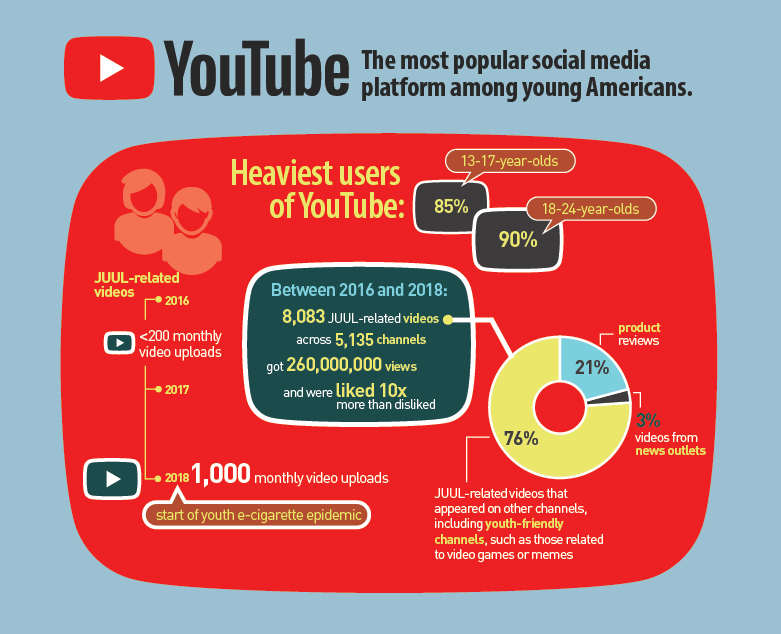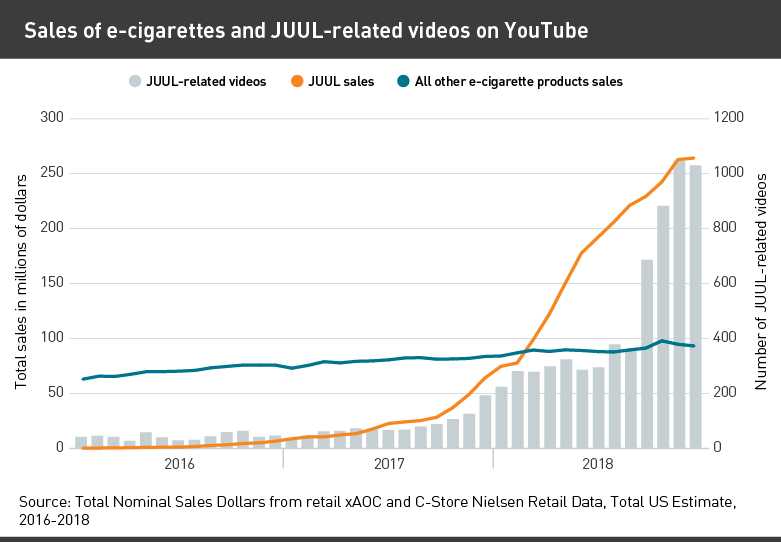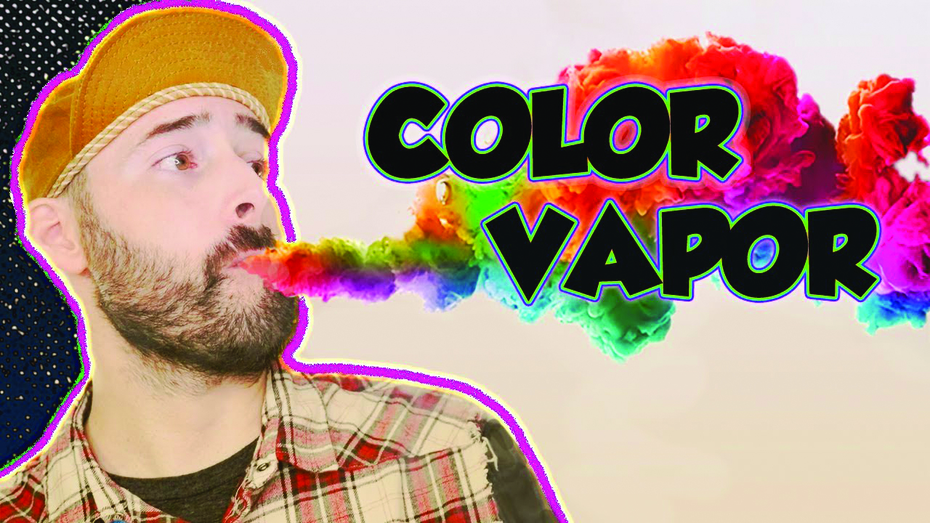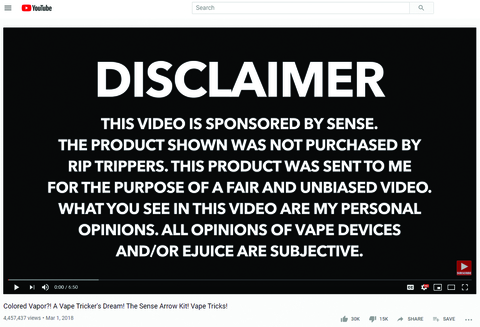
JUUL on YouTube
Examining viral vaping videos and the youth e-cigarette epidemic
A dramatic increase in JUUL-related videos on YouTube mirrored the surge in both the sales of the popular e-cigarette and the rates of youth vaping, according to a Truth Initiative® and University of Chicago analysis.
Researchers found more than 8,000 JUUL-related videos that received a total of 260 million views over the 3-year period from 2016 to 2018. Many videos appeared on youth-friendly channels, such as those related to popular memes or video games, and nearly one-quarter of all JUUL-related videos were product reviews with content directly related to use of the product.
The number of JUUL-related videos uploaded by users each month grew from less than 200 in 2016 and 2017 to more than 1,000 by the end of 2018, when the U.S. surgeon general declared a youth vaping epidemic. JUUL continues to dominate the e-cigarette market and is largely responsible for driving the worsening epidemic. Data from the 2019 National Youth Tobacco Survey show that more than 5 million youth are now vaping, including more than a quarter of high schoolers (27.5%), up from 20.8% in 2018.
Understanding the nature of these videos — their volume, content, views and likes — can provide critical information on the material youth may be exposed to on YouTube and how it could influence their behavior when it comes to vaping. Researchers from Truth Initiative and NORC at the University of Chicago’s Social Data Collaboratory found that the number of JUUL-related videos soared along with JUUL’s rising sales. Among the most viewed and well-liked videos were product reviews and content directly related to JUUL usage. The assessment also revealed that viewers “liked” videos posted by product reviewers — young people or adults who discussed and tried e-cigarette products — at a higher rate compared to videos produced by established sources like news channels, which shared more general and objective information on vaping.
More than 8,000 JUUL-related YouTube videos (nearly a quarter of them product reviews) received a total of 260 million views from 2016 through 2018.
Of the 8,083 JUUL-related videos included in the study, the majority were on meme, vlogger, gamer and other channels that appeal to youth. More than 20% — 1,707 videos — were product reviews. The overall volume of videos and substantial number of product reviews suggest JUUL-related content, especially content related to using the product, is widely accessible and on-demand to teens and young adults on YouTube. These videos help viewers learn about new products, how to use them, and can shape opinions about vaping which in turn normalizes risky behavior.

JUUL-RELATED VIDEOS WENT VIRAL OVER THREE YEARS AS JUUL USE ROSE
YouTube is the most popular social media platform among U.S. teens and young adults — 85% of youth ages 13-17 and 90% of young adults ages 18-24 use the site. Videos on YouTube are easily accessed and widely shared between users and their social networks.
User-generated videos about vaping — those that feature reviews, rate products or promote brands — are particularly popular. While YouTube policies prohibit content depicting minors vaping, the site does not prevent any age group from viewing or commenting on vape-related material. It is also not clear how well this policy is enforced. For example, researchers estimated that 5% of videos featuring vape tricks were posted by “vape enthusiasts” whose age they perceived to be younger than 18 years old.
JUUL-related videos increased dramatically over the three-year study period from 2016-2018 and received many “likes,” demonstrating their growing popularity.
- Millions of views
Between 2016 and 2018, JUUL-related videos generated 260 million views across 8,083 videos and 5,135 channels. - Videos liked much more than disliked
“Likes” and “dislikes” are an easy way for viewers to rate what they watch on YouTube and are a good indication of what is popular. On average, JUUL-related videos were viewed 35,000 times and liked 10 times more than they were disliked. - Sharp increase in content as JUUL became more well-known
The surge in JUUL-related content on YouTube mirrored the rapid growth of JUUL sales, picking up momentum in 2017 and spiking dramatically in 2018. While the number of monthly JUUL-related videos posted remained below 200 per month throughout 2016 and 2017, this number grew exponentially during the end of 2018, when more than 1,000 JUUL-related videos were posted per month in November and December. This trend suggests peer networks, especially when virtual, can easily share beliefs and may potentially normalize risky behaviors such as vaping.

MANY VIDEOS APPEARED ON YOUTH-FRIENDLY CHANNELS
Most of the JUUL-related videos were found on youth-friendly channels, highlighting their appeal among young people.
- Most content found on meme, vlogger, gamer and other channels
More than three-quarters (76%) of JUUL-related videos were posted on other types of channels, including those devoted to youth-appealing, entertainment-related content. This suggests that JUUL has become ubiquitous across YouTube and frequently incorporated into youth-friendly channels, such as those related to video games or memes. - Nearly one-quarter of all videos were product reviews
Of the 8,083 JUUL-related videos included in the study, 1,707 videos — 21% — were product reviews. This number is not insignificant given that YouTube is a site where youth gather information, gain “how to” knowledge and learn how products are being used by peers and influencers. - Only 3% of JUUL-related videos were from news channels
Of the 8,083 videos included in this study, only 229, or 3% of all JUUL-related videos, were classified as news videos from television, newspaper, online and radio news outlets. This underscores a lack of objective information related to harms and risks about JUUL products on YouTube.
Finding JUUL content on YouTube
To determine how much and what type of vaping content exists on YouTube, researchers from Truth Initiative and NORC at the University of Chicago’s Social Data Collaboratory retrospectively searched a collection of YouTube videos from 2016 to 2018 for use of the term “JUUL.” JUUL was selected as a search term because of its rapid rise during the timeframe of the study. By 2018, JUUL was the most popular e-cigarette on the market.
Researchers identified JUUL-related videos based on the video titles or descriptions, tags assigned to the content by the creator, and text in the name of the channel (i.e., the homepage for the user’s account). They then summarized the popularity of each video and channel including total views and number of “like” and “dislike” ratings from viewers.
In order to understand what youth may be exposed to on YouTube, researchers investigated the volume (number of videos), reach (number of views) and acceptability (ratio of “like” to “dislike”) of videos. For all news and product review videos, the researchers further categorized the general content discussed or promoted (e.g., flavor, discounts, nicotine, URL/website links) in the titles, tags or descriptions of these videos.
PRODUCT REVIEWS MORE POPULAR THAN NEWS CONTENT
The study found viewers far preferred information from peers or informal self-proclaimed experts like product reviewers rather than from more vetted sources, like news channels.
- Product review videos were “liked”
The 10 most-viewed product review videos alone were viewed on average more than 2 million times and received an average “like” to “dislike” ratio of 21.5 “likes” to 1 “dislike,” indicating their popularity and virality. - News channels more informative but not popular
News videos sometimes provided more credible information about vaping, particularly regarding nicotine content, but generated far fewer views and viewer “likes.” The 10 most-viewed news videos received an average view count of 1 million views and average “like” to “dislike” ratio of 8.4 “likes” to 1 “dislike.” - Flavor and nicotine common topics in review videos
Approximately one-quarter of product review videos, and one-third of news videos, contained descriptors related to flavor or nicotine. Examples included mentions of different flavors of JUUL pods or nicotine concentrations in pods or e-liquids.
HIGH QUALITY PRODUCTION OF PRODUCT REVIEW VIDEOS
Vape review channels frequently featured hosts who claimed to possess a high level of product knowledge. Many were also edited or sensationalized to engage viewers and get them to subscribe to the channel, including one viral video alleging to produce color vapor.

Viewers were “clickbaited” by this image with a claim of “colored vapor” when, in fact, the device simply includes a light which you can point at the vapor cloud.
INDUSTRY-SPONSORED REVIEWER VIDEOS
While some of the reviewer videos clearly identified that they were funded by the vape industry, others revealed industry ties only implicitly through promotional discounted offers. This raises questions about how much sway the vaping industry has over the content and sheer number of vaping videos being circulated on YouTube. It is unclear how many young people knew when vape-related content they viewed on YouTube was industry-sponsored.
NEED FOR MORE FEDERAL OVERSIGHT
The amount of popular JUUL content on YouTube underscores the importance of federal oversight of social media platforms. At a time when vaping among youth and young adults is at epidemic and unprecedented levels, any content that normalizes, glamorizes or encourages tobacco use among young people should be strictly regulated within the full extent of the law. The Federal Trade Commission (FTC) should use its regulatory powers to ensure that all paid reviews and other advertising by either retailers or manufacturers is clearly noted as a paid review. This should include those that have links to coupons or other promotions. The Food and Drug Administration (FDA) should also use its authority to restrict social media marketing when it grants marketing orders for new products. We know that tobacco imagery in popular culture contributes to the renormalization of tobacco use and believe that restricting such imagery is critical to protect the health of all Americans — particularly young people.
Vaping content on sites like YouTube matters because research shows that exposure to pro-tobacco messages on social media can lead to youth trying tobacco products. Exposure to promotional content can also potentially lead to increased use. In order to properly regulate content, it is important to distinguish between manufacturer or retailer paid or sponsored content and content posted by the general public. Due to First Amendment considerations, content posted by the general public on YouTube is largely unregulated and there are few consequences for displaying inaccurate or incorrect content. Manufacturers and retailers of tobacco products, however, must meet FTC and FDA regulations.

Misinformation in consumer-generated content is particularly dangerous because it can affect how people evaluate a product’s riskiness, shapes norms around product safety and use and can ultimately influence young people’s behavior. A great deal of misinformation about vaping already exists in popular culture and among young people particularly. A 2018 Truth Initiative study published in Tobacco Control found that among current youth and young adult JUUL users, the majority — 63% — did not know that JUUL, as designed, always contains nicotine. Thus, it is important that social media sites like YouTube and others establish policies that would reduce such misleading content, and minimize youth exposure to any tobacco imagery. Social media sites, for example, should consider prohibiting tobacco imagery on their sites. Until such a system is in place, one immediate step would be for social media sites to implement a rating system that indicates when content contains tobacco imagery so that parents have a better sense of what their children are watching. Stringent FTC and FDA restrictions on promotional marketing must complement any voluntary regulation of consumer-generated content on YouTube and other social media sites.
Although the current study focused on JUUL, the lessons learned provide insight into how social media platforms may be used to promote other novel tobacco products, such as the rapidly growing cadre of disposable JUUL-like devices (e.g., Puff Bars) as well as heated tobacco devices and dissolvable tobacco products. While the popularity of various social media platforms waxes and wanes, YouTube is likely to remain a source of information for youth in the near term. The ability of any one site to shape both minds and behavior should not go unchecked. Ending the epidemic of youth vaping will require a multifaceted approach that includes reducing or removing content from social media platforms that encourage youth use.
More in tobacco in pop culture
Want support quitting? Join EX Program
By clicking JOIN, you agree to the Terms, Text Message Terms and Privacy Policy.
Msg&Data rates may apply; msgs are automated.



